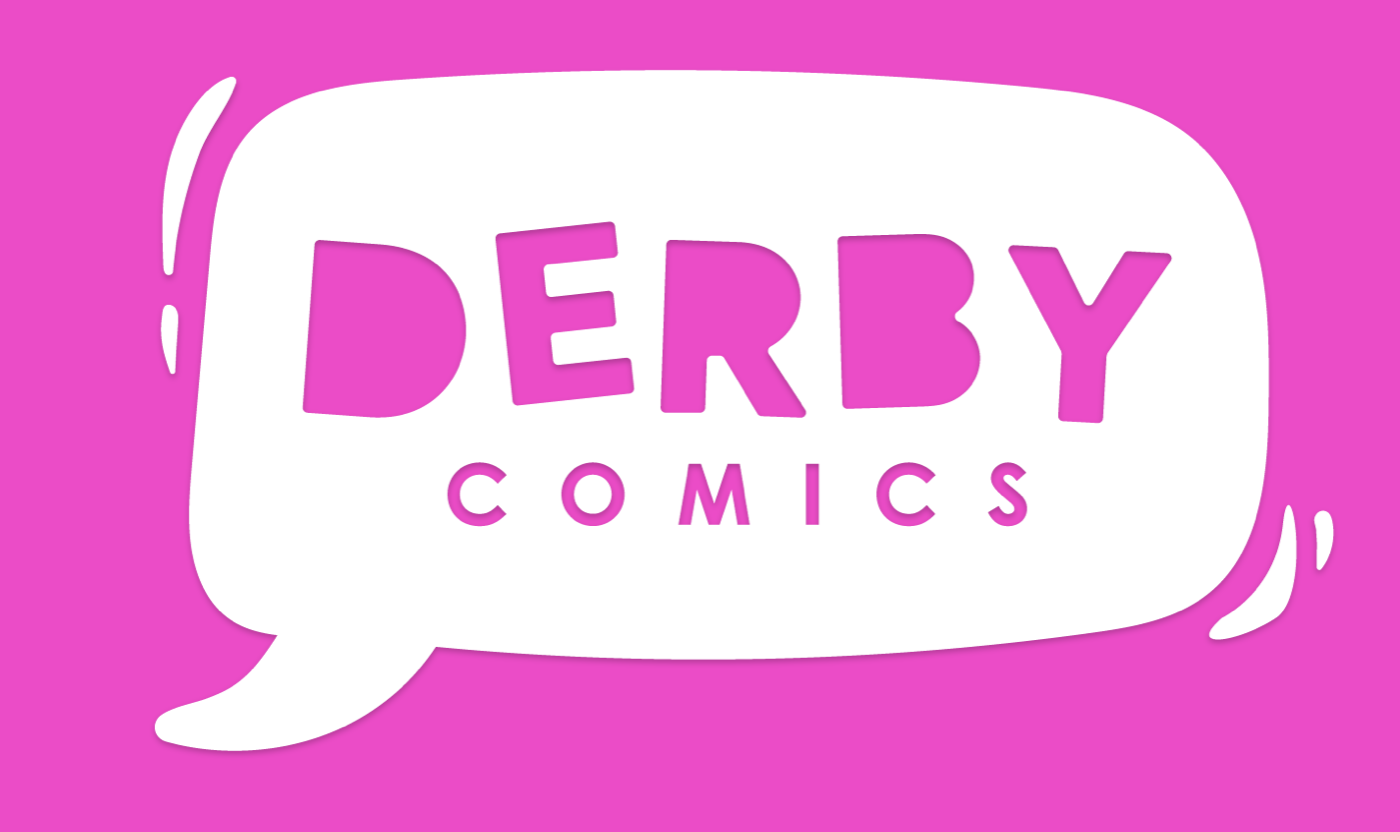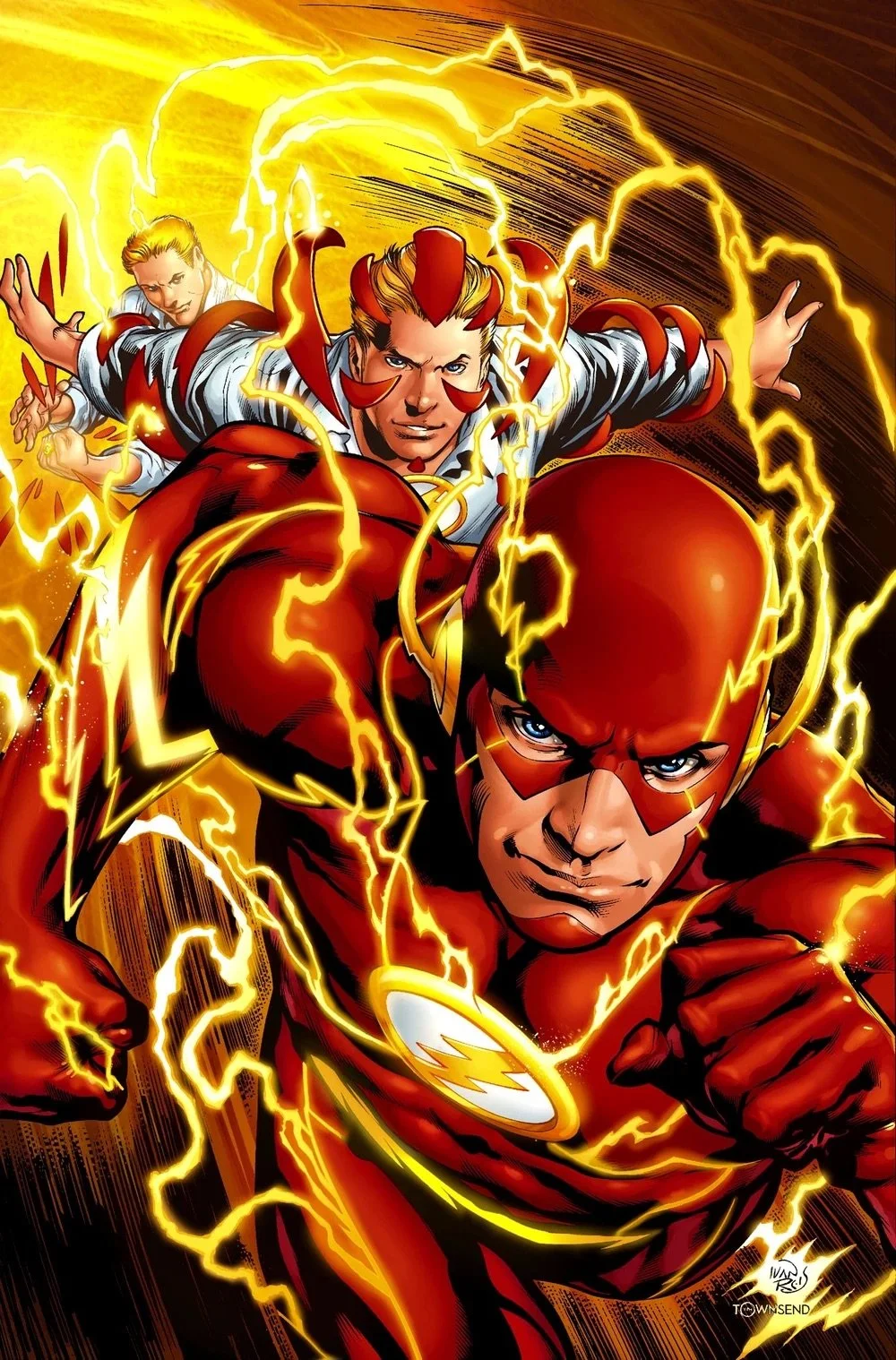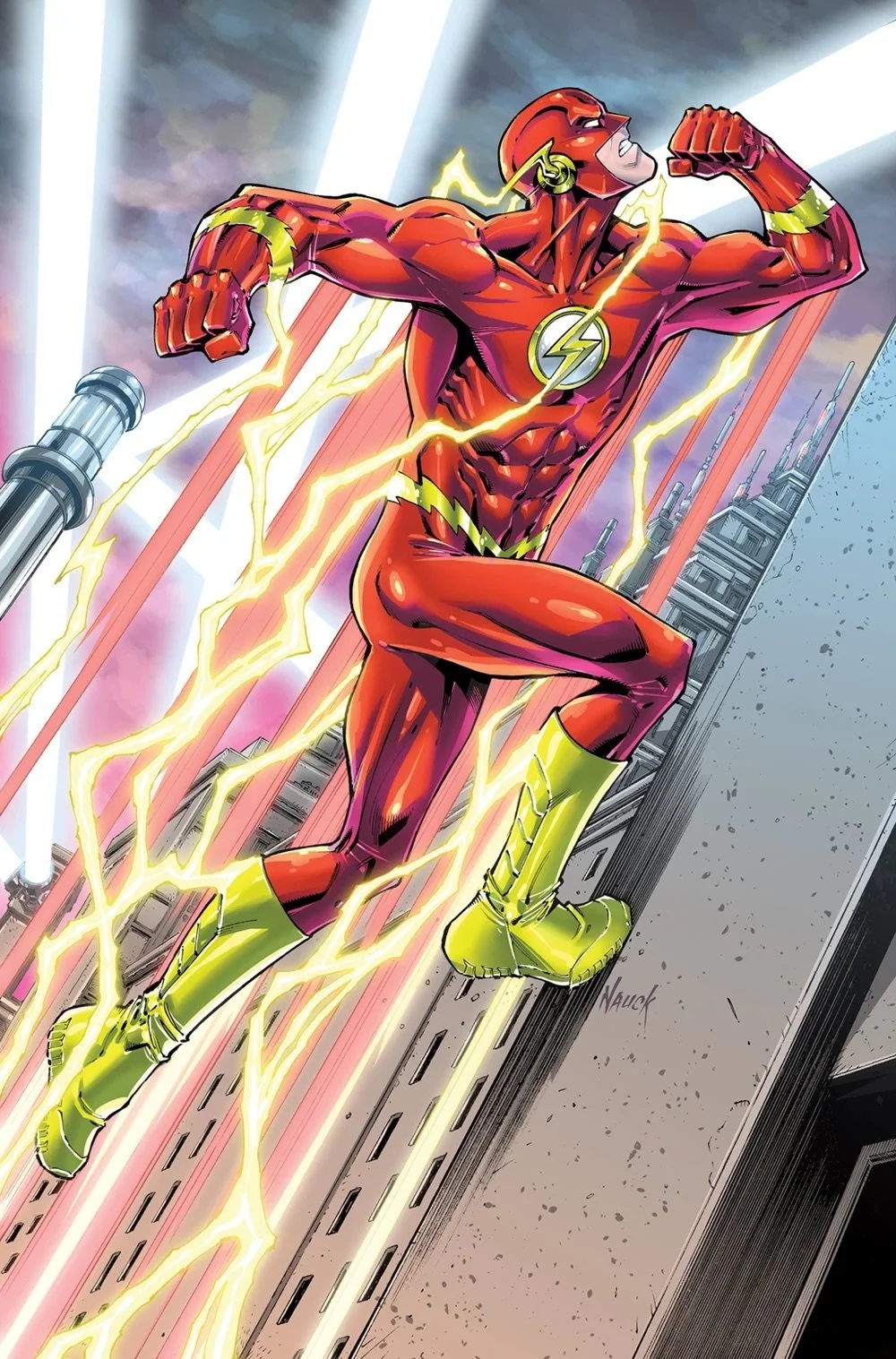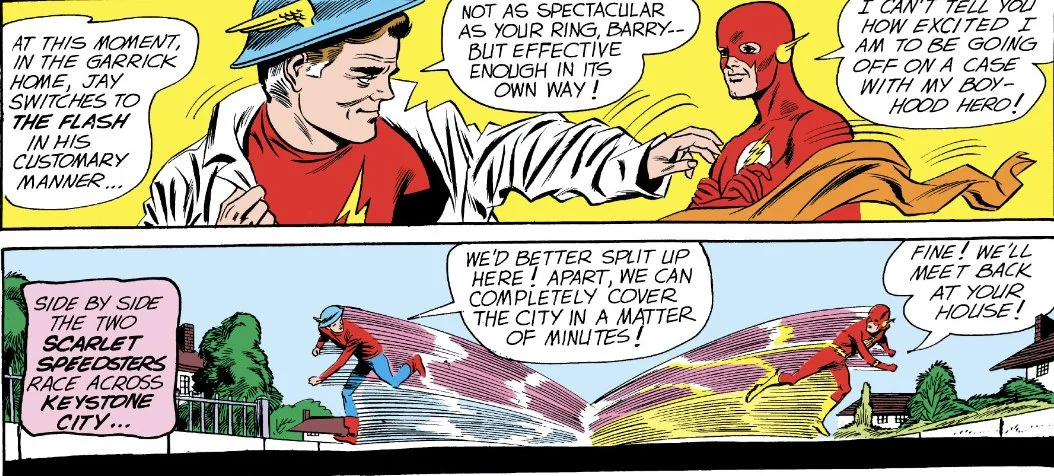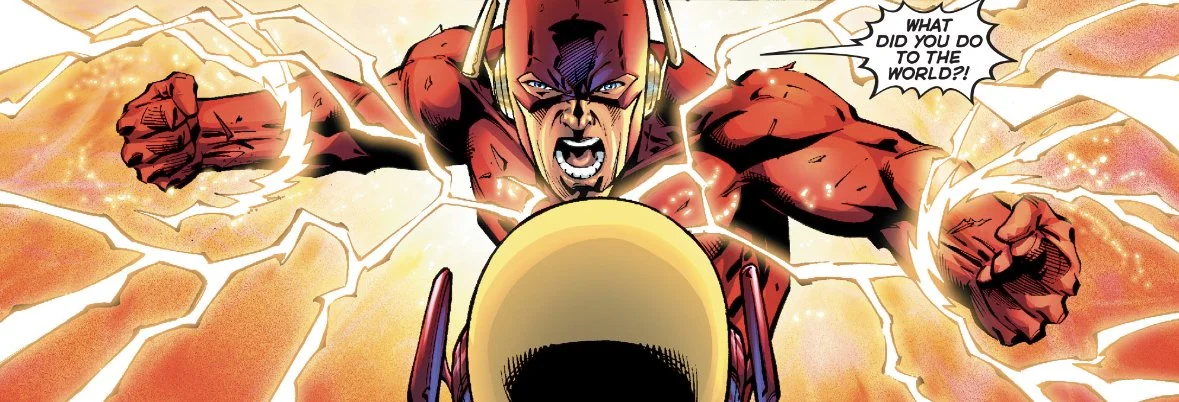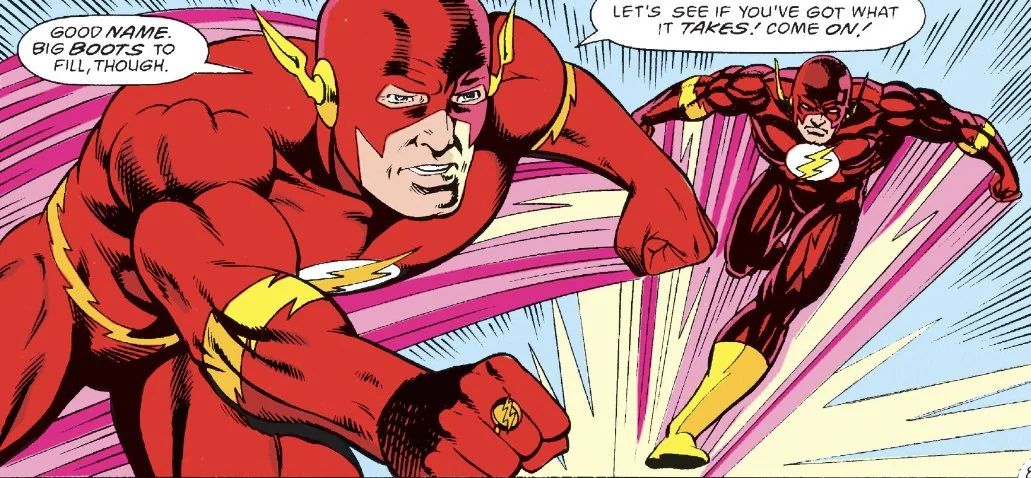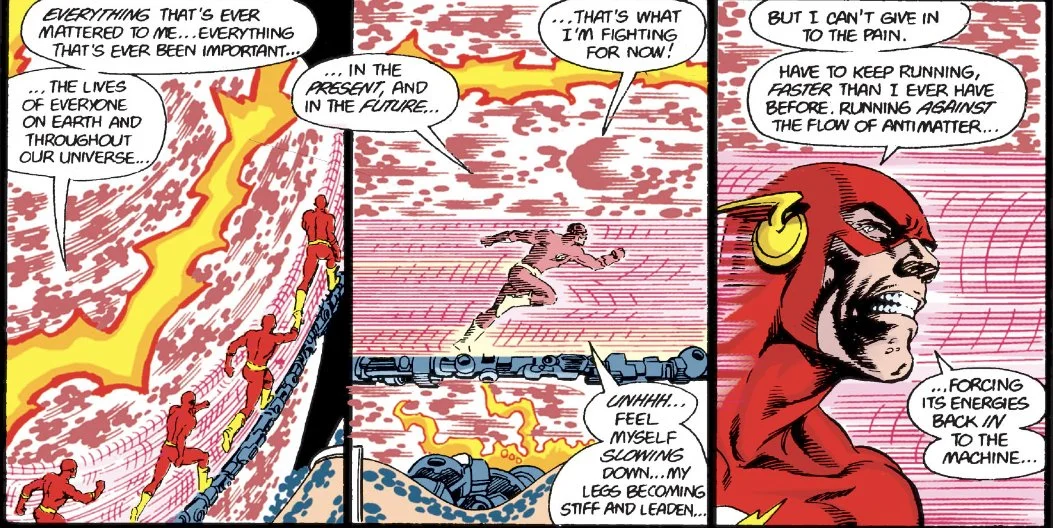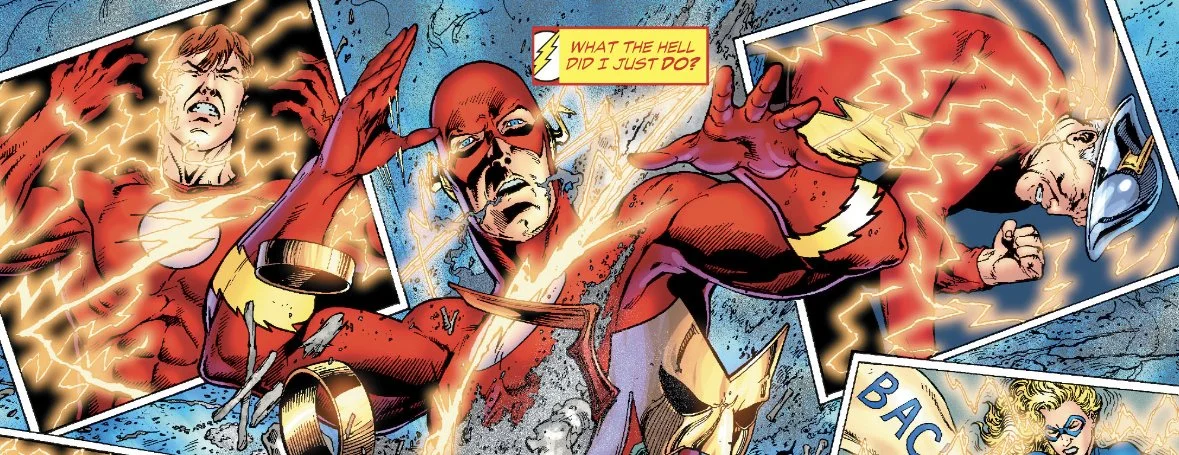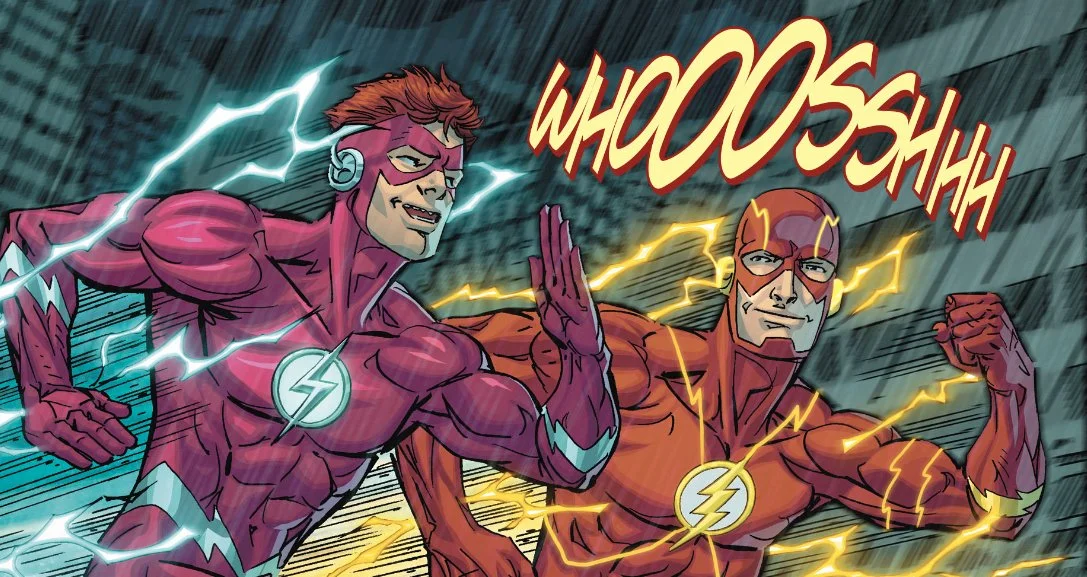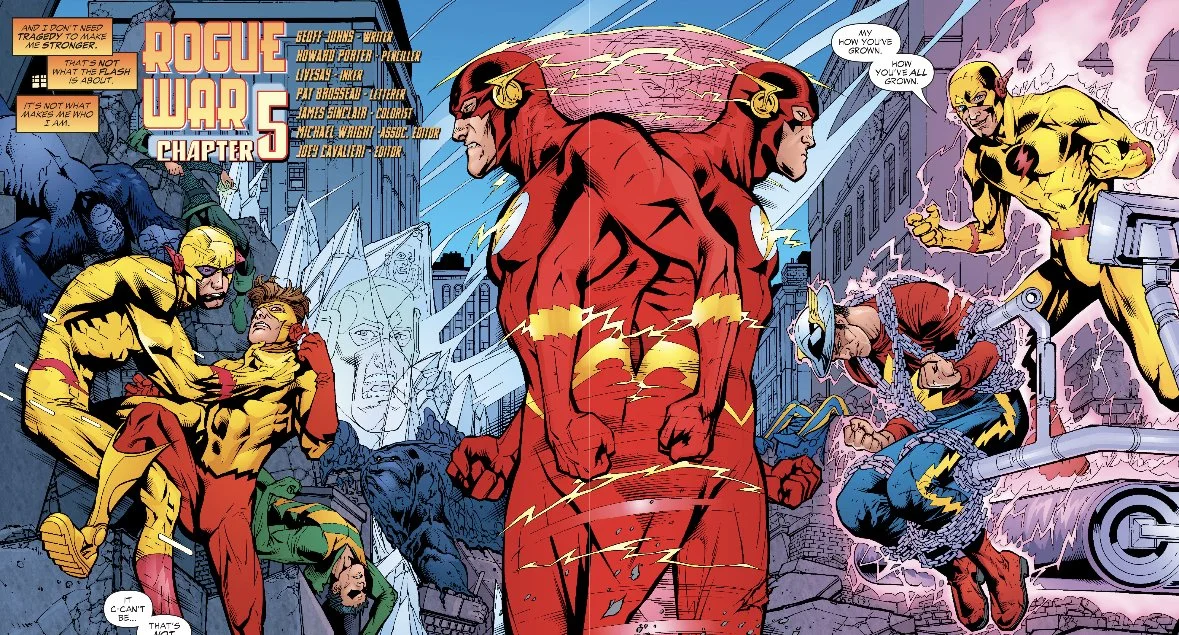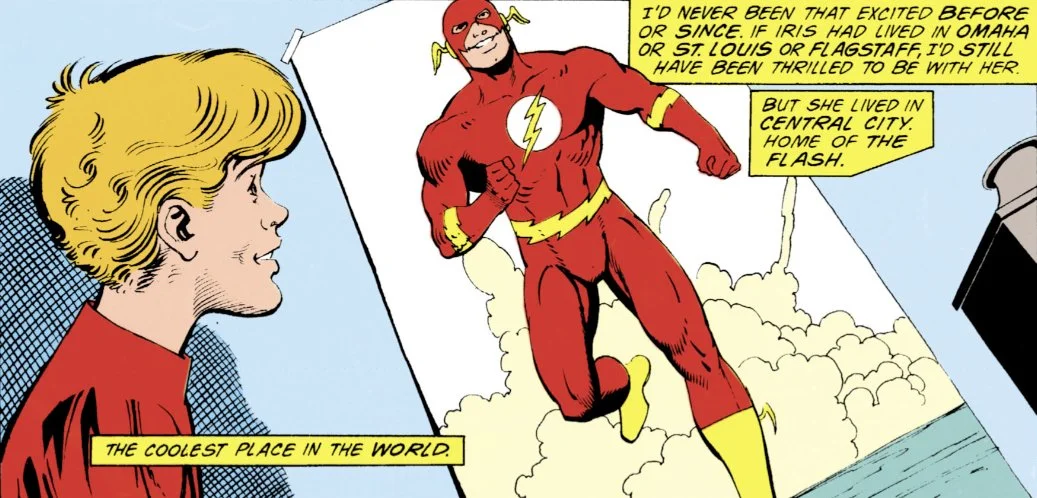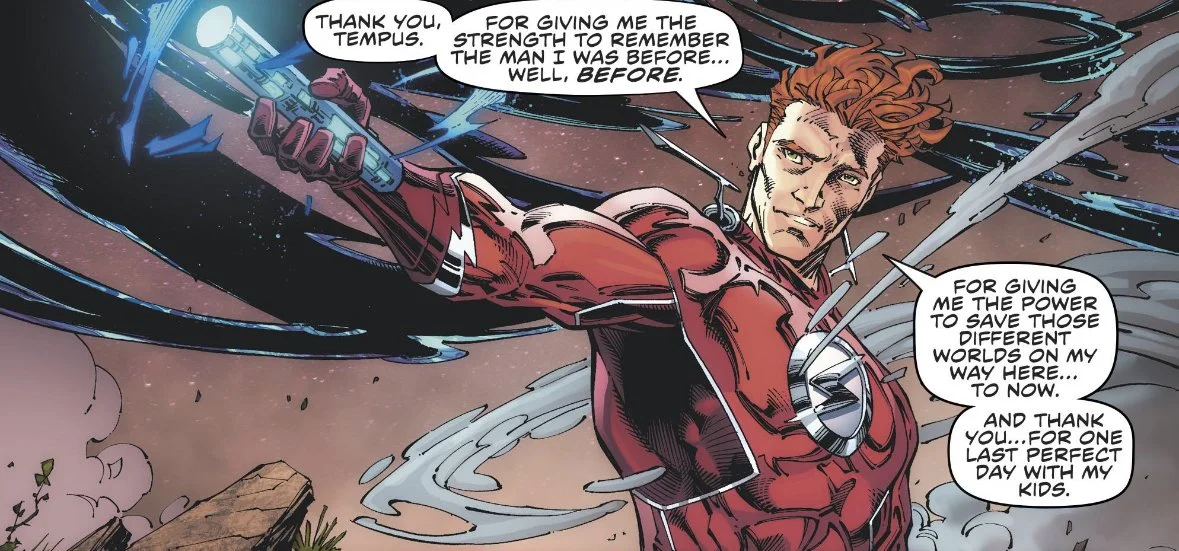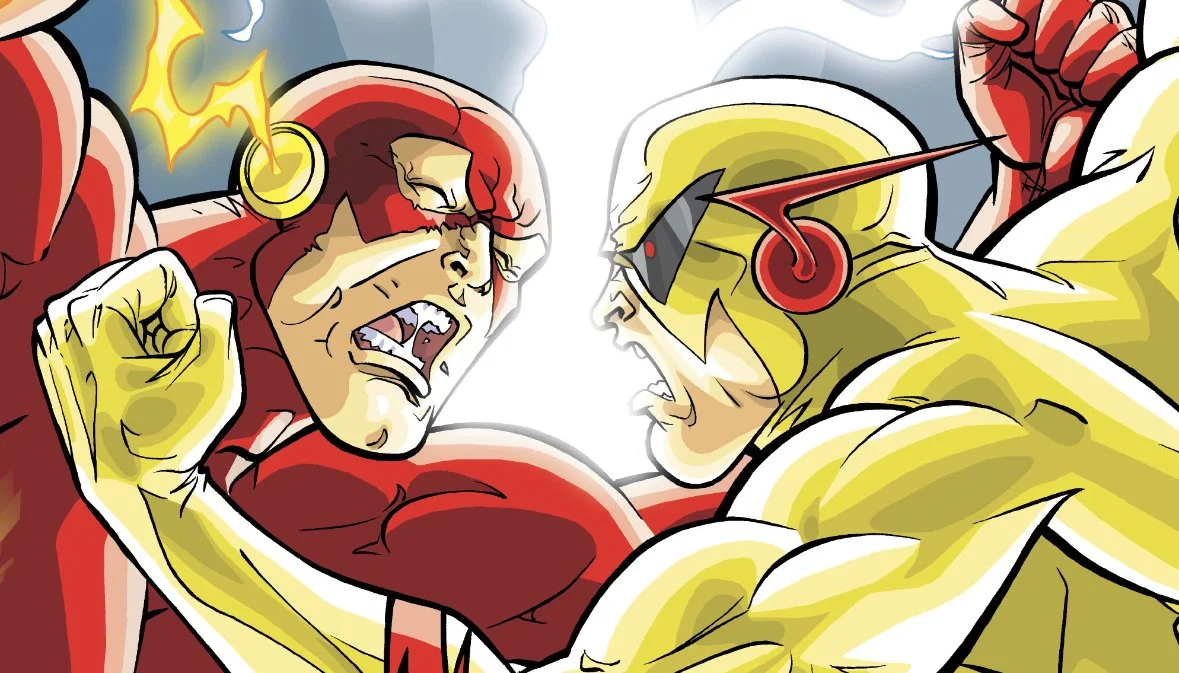Looking Back on Ten Iconic Flash Story Arcs
Credit: DC Comics
The Flash, one of DC Comics' most iconic and beloved superheroes, has captivated readers for decades with his incredible speed and heroic adventures. From his debut in 1940 to the present day, the Scarlet Speedster has raced through time, faced formidable villains, and played a pivotal role in shaping the DC Universe.
In anticipation of the theatrical release for The Flash this week, let’s take a look back at three of the most famous characters who have used the Flash moniker and then dive into some of the most iconic story arcs featuring The Flash from the comics!
Jay Garrick
Credit: DC Comics
The original Flash, Jay Garrick debuted in 1940 during the Golden Age of Comics. Created by writer Gardner Fox and artist Harry Lampert, Jay Garrick's character was inspired by the Greek god Hermes.
Jay Garrick's origin story depicts him as a college student who, during an experiment gone awry, inhales hard water vapors, granting him superhuman speed. Using his newfound powers, Jay becomes the costumed hero known as The Flash, donning a winged metal helmet and a red shirt with a lightning bolt emblem.
As The Flash, Jay Garrick fights crime and protects the fictional Keystone City. He became a founding member of the Justice Society of America, a team of superheroes who joined forces to combat threats during World War II.
Barry Allen
Credit: DC Comics
Perhaps the most well-known Flash, Barry Allen debuted in Showcase #4 in 1956, marking the beginning of the Silver Age of Comics. Created by writer Robert Kanigher and artist Carmine Infantino, Barry Allen became the modern incarnation of The Flash.
Barry Allen's origin story revolves around a freak accident in his crime lab, where he is struck by lightning and doused in a combination of chemicals and electrified chemicals. This incident grants him superhuman speed and the ability to tap into the Speed Force, a cosmic energy source that powers his abilities.
As The Flash, Barry Allen fights crime and protects Central City and Keystone City, often teaming up with other superheroes in the DC Universe. He is known for his iconic red costume with a lightning bolt emblem and his scientific approach to crime-solving.
Wally West
Credit: DC Comics
First appearing in 1959’s The Flash #110, Wally West was created by writer John Broome and artist Carmine Infantino.
Wally West's origin story starts when he is introduced as the nephew of the second Flash, Barry Allen. After an accident involving a chemical-filled electric battery, Wally gains the same superhuman speed powers as his uncle. Initially taking on the name Kid Flash, Wally becomes a sidekick to Barry Allen's Flash and a member of the Teen Titans.
Over time, Wally West transitions from sidekick to his mentor to taking up the mantle of The Flash himself. After Barry Allen's apparent death during the Crisis on Infinite Earths event, Wally steps into the role of the primary Flash and becomes a full-fledged superhero in his own right.
Ten of the Most Iconic Flash Storylines
The Flash of Two Worlds
Credit: DC Comics
"The Flash of Two Worlds" is a landmark story published in The Flash #123 in 1961 and is widely considered one of the most significant stories in comic book history. It was written by Gardner Fox with art by Carmine Infantino and marked the introduction of the concept of the Multiverse in DC Comics.
In the story, Barry Allen discovers that he can vibrate at a certain frequency that allows him to travel between dimensions. He inadvertently finds himself on Earth-Two, a parallel Earth that exists in a different vibrational frequency. On Earth-Two, he encounters Jay Garrick, the original Flash, who had previously been assumed to exist only as a fictional character in comic books on Barry's Earth-One.
The meeting between Barry Allen and Jay Garrick establishes the concept of the Multiverse, revealing that the characters from the Golden Age (Earth-Two) and the Silver Age (Earth-One) of comics exist on separate Earths within the DC Universe. This concept was a way for DC Comics to explain the continuity differences between their earlier and more contemporary superhero stories.
"The Flash of Two Worlds" is significant because it paved the way for future crossovers and team-ups between characters from different Earths, expanding the DC Universe and its mythology. The story also created a strong connection between the two generations of Flash characters and opened the door for other DC superheroes to interact across multiple Earths.
This story had a lasting impact on the DC Comics universe and became the foundation for many subsequent Multiverse-related storylines, including the epic crossover event "Crisis on Infinite Earths" in the 1980s. It solidified the concept of parallel Earths and became a beloved and iconic tale among Flash and DC Comics fans.
Flashpoint
Credit: DC Comics
"Flashpoint" was a major story arc published in 2011 and served as a crossover event that significantly impacted the DC Universe leading to a reboot of the entire DC comic universe continuity, known as "The New 52."
In the "Flashpoint" storyline, written by Geoff Johns with art by Andy Kubert, Barry Allen wakes up in an alternate reality where he no longer has his speed powers and the world is drastically different. He discovers that the timeline has been altered due to his attempt to save his mother from being murdered when he was a child. This alteration has caused a butterfly effect, leading to a vastly changed world.
Barry Allen realizes that he must regain his powers and fix the timeline to restore the proper reality. He embarks on a dangerous mission to gather allies and reverse the effects of his actions, all while facing formidable adversaries and navigating the complex web of this altered world.
"Flashpoint" is notable for its exploration of the consequences of time travel and its impact on the DC Universe. The storyline culminated in a grand finale that involved multiple heroes and villains, and ultimately set the stage for the relaunch of DC's comic book line with "The New 52," which introduced a revised continuity for many of the characters.
The impact of "Flashpoint" reverberated throughout DC Comics, leading to new storylines, character reboots, and a fresh starting point for readers. It remains a significant and memorable chapter in The Flash's history and the wider DC Universe.
The Return of Barry Allen
Credit: DC Comics
This storyline took place from The Flash #74 to #79 and was written by Mark Waid with art by Greg LaRocque.
In this story arc, Wally West, who had been serving as The Flash since the death of his mentor Barry Allen during the Crisis on Infinite Earths event, faces a shocking turn of events. A man claiming to be Barry Allen suddenly appears, seemingly returned from the dead. This imposter possesses all of Barry's memories and powers, leading Wally and the rest of the Flash family to believe that the original Flash has indeed come back.
However, as the story progresses, Wally begins to suspect that this Barry Allen is not who he claims to be. Strange behavior and inconsistencies arise, casting doubt on the imposter's true identity. Wally's trust and sense of self are tested as he grapples with the possibility that the man he thought was his mentor and friend may be an impostor with malicious intentions.
"The Return of Barry Allen" delves into themes of identity, legacy, and the passing of the torch. It explores Wally West's struggle to step out of the shadow of his predecessor and establish himself as a worthy successor to the Flash mantle. The story delves deep into Wally's emotional journey as he confronts the imposter and ultimately uncovers the truth behind his return.
This storyline not only brought back the iconic character of Barry Allen but also had a significant impact on Wally West's development as a hero. It further solidified his place as the rightful heir to the Flash legacy and explored the complex dynamics between the different generations of speedsters in the DC Universe.
"The Return of Barry Allen" is regarded as a standout arc in The Flash's history, blending superhero action with emotional depth and character exploration. It showcases the enduring legacy of Barry Allen and the importance of embracing one's own identity while honoring the past.
Crisis on Infinite Earths
Credit: DC Comics
Barry Allen’s Flash played a pivotal role in this seminal event series written by Marv Wolfman and illustrated by George Pérez.
In the story, the DC Multiverse, which consisted of various parallel Earths with different versions of DC superheroes, faced an existential threat from an all-powerful being known as the Anti-Monitor. The Anti-Monitor sought to destroy the Multiverse and merge all the Earths into a single, antimatter-dominated universe.
Barry Allen was one of the key heroes who joined forces with other DC superheroes to combat the Anti-Monitor's destructive plans, playing a heroic and self-sacrificing role throughout the series.
In Issue #8, Barry races towards the Anti-Monitor's anti-matter cannon, intending to destroy it and save the remaining Earths. As he runs at an incredible speed, Barry realizes that the only way to succeed is to tap into the power of the Speed Force, a cosmic energy source that grants superhuman speed abilities to speedsters.
With the aid of the Speed Force, Barry’s heroic act shatters the anti-matter cannon, but at a great cost. He becomes one with the Speed Force, sacrificing himself to save the Multiverse. Barry's selfless act serves as a turning point in the battle against the Anti-Monitor and inspires other heroes to continue the fight.
Barry Allen's sacrifice had a profound impact on the DC Universe. His death became a defining moment in the Flash's history and left a lasting legacy. It set the stage for new iterations of The Flash, including Wally West, to take up the mantle and carry on Barry's heroic legacy.
The events of "Crisis on Infinite Earths" had a far-reaching impact on the DC Universe, leading to a reboot of continuity and reshaping the overall narrative landscape. It remains one of the most significant and influential crossover events in comic book history, with The Flash's role serving as a poignant and memorable part of the storyline.
Rebirth
Credit: DC Comics
Captured within a six-issue miniseries published in 2009, it was written by Geoff Johns and illustrated by Ethan Van Sciver. "Rebirth" serves as a relaunch and reintroduction of the Flash mythos following the events of "Final Crisis" and "The Flash: The Fastest Man Alive" series.
In the storyline, Barry Allen returns from the Speed Force, the energy field that grants speedster powers. His resurrection brings about various repercussions and mysteries surrounding the Speed Force and its connection to other speedsters.
As Barry navigates his return, he must confront the Black Flash, a personification of death for speedsters. Additionally, he uncovers a plot involving his arch-nemesis, Eobard Thawne (also known as Professor Zoom or the Reverse-Flash), who seeks to manipulate the Speed Force for his own twisted purposes.
Throughout "Rebirth," Barry grapples with memories of his previous life, his role as a hero, and his place among the other speedsters in the DC Universe. The story explores the legacy of the Flash and delves into the intricacies of the Speed Force, shedding new light on its significance and potential dangers.
"Rebirth" not only sets the stage for Barry’s return but also establishes important plot points and character developments that have reverberated throughout subsequent Flash storylines. It plays a significant role in reestablishing Barry as the primary Flash in the DC Universe, paving the way for ongoing series and events featuring the Scarlet Speedster.
The impact of "Rebirth" extends beyond this miniseries, as it contributed to the revitalization of the Flash franchise and reinvigorated interest in the character. It serves as a key chapter in the Flash's comic book history, reestablishing Barry as a central figure and setting the stage for new adventures and challenges.
Flash War
Credit: DC Comics
The "Flash War" story arc was a crossover event that took place in The Flash #46-#50 from 2018 to 2019. It was written by Joshua Williamson and featured artwork by Howard Porter.
The storyline revolves around a clash between Barry Allen and Wally West due to the revelation that Wally's children from a pre-Flashpoint timeline, Jai and Iris West, have been erased from existence. Wally blames Barry for this tragedy, holding him responsible for tampering with the timeline during events like "Flashpoint" and "Rebirth."
The story explores the complex dynamic between Barry and Wally as they confront their differences and confront their shared past. As the two speedsters clash, their speed powers reach unprecedented levels, causing a rupture in the Speed Force itself. This rupture threatens the stability of the entire DC Universe, prompting other heroes, including Batman and Superman, to intervene and attempt to contain the situation.
Throughout the "Flash War" storyline, various speedsters from the Flash family, including Jay Garrick, Jesse Quick, and Max Mercury, also play significant roles. The story delves into the consequences of manipulating time, the emotional toll of loss and regret, and the sacrifices heroes are willing to make for the greater good.
Rogue War
Credit: DC Comics
“Rogue War" took place in issues The Flash #220-#225 and was written by Geoff Johns as a conclusion to his first run on the title.
In the the storyline, the Rogues, a group of super-powered criminals with specialized gadgets and abilities, including Captain Cold, Mirror Master, Weather Wizard, and others, unite to eliminate Barry Allen’s the Flash once and for all.
The central conflict arises when the Rogues' Gallery splits into factions, leading to a power struggle within their ranks. The two factions, one led by Captain Cold and the other by the villainous Zoom (also known as Reverse-Flash or Professor Zoom), engage in a brutal war for control.
As Barry becomes embroiled in the escalating conflict, he must navigate the complex dynamics between the Rogues and uncover the truth behind their motivations. The story explores the intricate relationships between the Rogues, their code of honor, and their deep-seated vendettas against the Flash.
Throughout the "Rogue War" storyline, readers are treated to intense battles, clever strategies, and unexpected alliances. The Flash faces off against various Rogues, each with their unique powers and tactics, testing his speed and resourcefulness.
Additionally, the story delves into the personal lives of the Rogues, shedding light on their histories, motivations, and individual struggles. The Flash's allies, including his wife, Iris West, and fellow speedsters such as Wally West (Kid Flash) and Bart Allen (Impulse), also play important roles in the narrative.
"Rogue War" is regarded as one of the definitive Flash storylines, offering a deep exploration of the Rogues Gallery while showcasing the Flash's ingenuity, heroism, and unwavering determination. The arc adds layers of complexity to the dynamic between the Flash and his adversaries, further solidifying the Rogues' status as iconic villains in the DC Universe.
Born to Run
Credit: DC Comics
The "Born to Run" story arc is a significant storyline in The Flash comics that explores the early years of Barry Allen. It was originally published in The Flash #62-#65, written by Mark Waid and illustrated by Greg LaRocque.
The story takes readers back to Barry Allen's childhood and follows his journey to becoming the Scarlet Speedster. The story unfolds through a series of flashbacks and presents key moments that shape Barry's life and his path towards becoming a hero.
The arc delves into Barry's childhood experiences, particularly his fascination with the idea of speed. It highlights his early encounters with his future wife, Iris West, and his friendship with Manuel Lago, also known as Chunk. These relationships play a significant role in Barry's development and shape his character as he grows into adulthood.
As the story progresses, readers witness Barry’s transformation into the Flash. They witness his training, his discovery of the Speed Force, and the iconic accident involving chemicals and lightning that grants him his superhuman speed.
"Born to Run" serves as an origin story for Barry Allen, shedding light on his motivations, values, and sense of responsibility as a superhero. It provides insights into the foundations of his crime-fighting career and the personal sacrifices he makes to protect Central City.
The arc also introduces other notable characters in Barry's life, including his supportive family, such as his father Henry Allen, and his fellow police officer and friend, Fred Chyre. These relationships deepen the emotional resonance of the story and highlight the importance of connections in Barry's life.
Flash Forward
Credit: DC Comics
The "Flash Forward" story was a six-issue miniseries published in 2019 written by Scott Lobdell and featured artwork by Brett Booth. "Flash Forward" serves as a continuation and expansion of the storylines established in "Heroes in Crisis" and "Dark Nights: Metal."
After the events of "Heroes in Crisis," Wally West is dealing with profound guilt and grief over the loss of his friends and the mistakes he believes he has made. Struggling to find his place in the world, he embarks on a journey of redemption.
Wally encounters the villainous Tempus Fuginaut, who offers him a chance to right his wrongs and regain control of his life. As Wally accepts this opportunity, he becomes entangled in a multiversal adventure that spans different dimensions and timelines.
Throughout "Flash Forward," Wally encounters various versions of himself, including different iterations of the Flash from alternate universes. These encounters provide opportunities for self-reflection, growth, and the exploration of Wally's past, present, and potential future.
The storyline delves into themes of identity, legacy, and the consequences of one's actions. It explores the emotional turmoil Wally experiences as he grapples with the weight of his past and strives to find redemption while confronting powerful cosmic forces.
"Flash Forward" also ties into the larger DC Universe, building upon the events of "Dark Nights: Metal" and setting the stage for the "Doomsday Clock" storyline. It expands on the concept of the Metaverse and the connections between various realities, paving the way for future stories and developments in the DC multiverse.
The "Flash Forward" story arc offers a character-driven exploration of Wally West's journey, his role as a hero, and his place in the larger DC mythology. It serves as a pivotal moment in Wally's ongoing character development and provides significant revelations and resolutions to his personal struggles.
Blitz
Credit: DC Comics
"Blitz" spans The Flash #192-#200 and was written by Geoff Johns, with artwork by Scott Kolins.
In "Blitz," Wally West faces one of his greatest challenges when a new villain, known as Zoom (Hunter Zolomon), makes his debut. Zoom possesses the ability to manipulate time and speed, making him a formidable adversary for the Fastest Man Alive.
The storyline kicks off with a devastating attack on Wally's personal life as Zoom targets his loved ones, including his wife, Linda Park. The ruthless Zoom not only inflicts physical harm but also plays psychological games with Wally, pushing him to his limits both emotionally and physically.
As the story progresses, Wally must confront his own doubts and fears while trying to protect those closest to him. He faces a series of intense battles with Zoom, who seemingly always stays one step ahead. The conflict between the Flash and Zoom escalates, leading to a dramatic climax that tests Wally's resolve and showcases the extent of his speedster powers.
What makes "Blitz" stand out is the exploration of the psychological toll that the events have on Wally West. The story delves into his doubts, insecurities, and the weight of responsibility he carries as a hero. It showcases his growth as a character and his determination to protect his loved ones despite the overwhelming odds.
Additionally, "Blitz" features appearances by other notable characters from the Flash's supporting cast, including Jay Garrick, Impulse, and the Rogues Gallery. Their involvement adds layers to the story and emphasizes the importance of teamwork and unity.
"Blitz" is praised for its intense action, emotional depth, and intricate storytelling. It is regarded as a significant chapter in the Flash's history and is often referenced as a standout storyline within the character's long and storied publication history.
